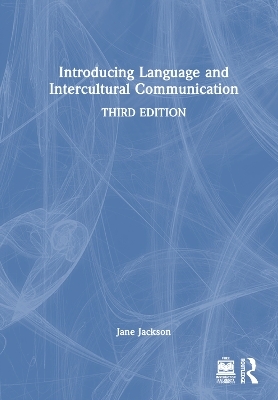
Introducing Language and Intercultural Communication
Routledge (Verlag)
978-1-032-36521-3 (ISBN)
Incorporating real-life examples from around the world and drawing on current research, this text argues against cultural stereotyping and instead provides students with a skill-building framework to enhance understanding of the complexities of language use and intercultural communication in diverse settings. Readers will learn to become more attuned to power relations and the ways in which a complex mix of internal and external factors can influence language choice/attitudes, the intercultural communication process, and intercultural relationship building.
Features new to this edition include:
‘pause and reflect’ boxes and images throughout each chapter that encourage meaning making and connections between theories and practice
dialogues and student accounts of intercultural experiences that link theories with real-life applications
discussion questions, journal jumpstarts, and suggested activities at the end of each chapter to engage students and provide a more interactive experience
new material that takes account of key social, cultural, and political events, such as the COVID-19 pandemic, the refugee crisis, the climate emergency, and the rise of populism
updated theoretical constructs that reflect recent developments in this area of study, such as criticality and reflexivity in intercultural communication
refreshed references and glossary to enhance understanding of key terms and concepts
revised and updated Instructor and Student Resources, including recommended resources on intercultural pedagogy, sample course schedules and assignments, in-depth chapter-specific resources, and a test bank
revised and updated student resources, including suggested readings and links to online resources, key terms for each chapter, e-flash cards, study quizzes, and a glossary
This is the essential textbook for introductory courses in language and intercultural communication within applied linguistics and communication studies.
Jane Jackson is Professor Emerita of Applied Linguistics and Intercultural Communication at the Chinese University of Hong Kong. She is also the editor of The Routledge Handbook of Language and Intercultural Communication, Second Edition (2020).
List of plates
List of figures
List of tables
Preface
Acknowledgments
Chapter 1. Imperatives for intercultural dialogue
Introduction
What is intercultural communication?
What is intercultural dialogue?
The importance of intercultural competency today
Ethical intercultural communication
Summary
Discussion questions
Journal jumpstarts
Activities
Instructor and Student Resources
Chapter 2. Culture, language, and primary socialization
Introduction
Conceptions of culture
Primary socialization (Cultural and linguistic)
Facets of culture
The text’s conception of culture
Summary
Discussion questions
Journal jumpstarts
Activities
Instructor and Student Resources
Chapter 3. Communication, culture, and power in context
Introduction
Human communication and language
Components in the human communication process
Properties of human communication
Culture and communication styles
Communication accommodation theory (CAT)
Characteristics of effective intercultural communicators in second-language situations
Summary
Discussion questions
Journal jumpstarts
Activities
Instructor and Student Resources
Chapter 4. Nonverbal communication
Introduction
What is nonverbal communication?
Why study nonverbal communication?
The relationship between verbal and nonverbal communication
Functions of nonverbal communication
Culture and types of nonverbal communication
The nonverbal expectancy violation theory
Nonverbal intercultural communicative competence
Summary
Discussion questions
Journal jumpstarts
Activities
Instructor and Student Resources
Chapter 5. Identity and belonging
Introduction
Conceptions of identity
Fundamental characteristics of identities
Types of identities
Identities and intercultural competence: Applying your knowledge
Summary
Discussion questions
Journal jumpstarts
Activities
Instructor and Student Resources
Chapter 6. The dark sides of identities: Barriers to intercultural communication
Introduction
Social categorization
Ethnocentricism
Othering
Ingroups and outgroups
Stereotyping
Bias and prejudice
Discrimination
Racism
Hateful rhetoric and acts of violence
Xenophobia
Pushing past ethnocentricism and identity biases
Summary
Discussion questions
Journal jumpstarts
Activities
Instructor and Student Resources
Chapter 7. Intercultural adaptation
Introduction
Transitioning to another land: Motives and duration of stay
Long-term and short-term adaptation
Dimensions of transition shock
Sources of language and culture shock
Symptoms of language and culture shock
Variations in the degree of language and culture shock
Positive and negative effects of language and culture shock
Navigating the ups and downs of intercultural adaptation
Optimizing intercultural transitions
Summary
Discussion questions
Journal jumpstarts
Activities
Video and online resources
Notes
Instructor and Student Resources
Chapter 8. Intercultural relationships
Introduction
Interpersonal relationships
Intercultural relationships and diversity
Intercultural friendship and diverse social networks
Benefits of intercultural friendship
Factors that facilitate intercultural friendship
Barriers to intercultural friendship
Intercultural romance and marriage
How to build stronger intercultural relationships
Summary
Discussion questions
Journal jumpstarts
Activities
Instructor and Student Resources
Chapter 9. Intercultural conflict
Introduction
The nature and characteristics of conflict
Types of conflict
Cultural dimensions of conflict situations
Intercultural conflict styles
Facework and intercultural conflict management
Conflict competence
Managing language and intercultural conflict situations
Summary
Discussion questions
Journal jumpstarts
Activities
Instructor and Student Resources
Chapter 10. Diversity and inclusion in the global workplace
Introduction
Globalization, diversity, and inclusion in the workplace
Englishization and the global workforce
The benefits of diversity and inclusion in the workplace
The challenges of diversity in the workplace
Cultural difference frameworks and the global workplace
Alternative approaches to intercultural business research, education, and practice
Enhancing intercultural communication and inclusivity in today’s global workplace
Summary
Discussion questions
Journal jumpstarts
Activities
Instructor and Student Resources
Chapter 11. Intercultural competency and global citizenship
Introduction
Intercultural competency
Intercultural-global competency and citizenship
Requisite competencies for today’s global society
Enhancing intercultural competence and global citizenship
Summary
Discussion questions
Journal jumpstarts
Activities
Instructor and Student Resources
References
Glossary
Index
| Erscheinungsdatum | 14.11.2023 |
|---|---|
| Zusatzinfo | 4 Tables, black and white; 5 Line drawings, black and white; 96 Halftones, black and white; 101 Illustrations, black and white |
| Verlagsort | London |
| Sprache | englisch |
| Maße | 174 x 246 mm |
| Gewicht | 966 g |
| Themenwelt | Geisteswissenschaften ► Sprach- / Literaturwissenschaft ► Anglistik / Amerikanistik |
| Geisteswissenschaften ► Sprach- / Literaturwissenschaft ► Literaturwissenschaft | |
| Geisteswissenschaften ► Sprach- / Literaturwissenschaft ► Sprachwissenschaft | |
| Sozialwissenschaften ► Kommunikation / Medien ► Kommunikationswissenschaft | |
| ISBN-10 | 1-032-36521-8 / 1032365218 |
| ISBN-13 | 978-1-032-36521-3 / 9781032365213 |
| Zustand | Neuware |
| Informationen gemäß Produktsicherheitsverordnung (GPSR) | |
| Haben Sie eine Frage zum Produkt? |
aus dem Bereich


